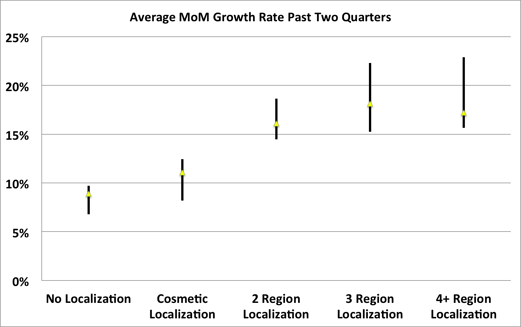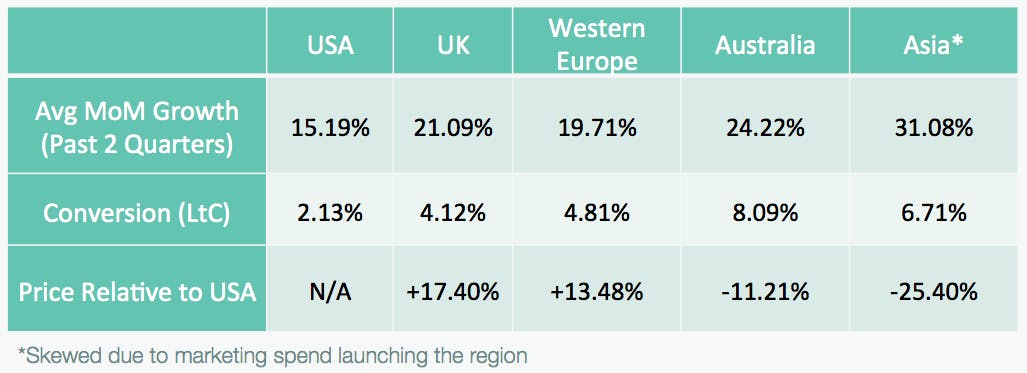Considering how important pricing is to your business and revenue, you’d be surprised by how many SaaS businesses overlook an incredibly important part of the pricing process: localization.
You wouldn't be alone in thinking that the US dollar is a universally accepted currency, and sufficient for selling SaaS internationally. While it’s a good universal price benchmark, only selling in $ could be causing you to miss out on revenue opportunities that are otherwise ready for the taking.
Customers can be quickly put off when prices aren’t in their native currency. But expanding into new markets and territories is not just about currency conversion, you need to consider pricing localization too. In fact, you need to consider pricing localization first .
Let’s take a look at what this means in practice.
What is localization?
Localization is the process of adapting your operations, strategies, tactics, and products in a specific state, country, or region to better serve the local audience. It involves adjusting your efforts and outputs to fit the culture, language, local market forces, and environment in the specific location.
What is pricing localization?
Pricing localization takes into account the location of buyers to determine factors like how to display pricing (currency and format) and what the most suitable price point and model is for selling in a given market. It's all about understanding the people and your competition in your target and using this information to customize your pricing for that segment of customers. It’s mindful of price perception and socio-cultural factors that will encourage customers to click that ‘Pay Now’ button.
There are two different types of pricing localization:
1) Cosmetic localization: Making sure prospects see prices in their currency
Cosmetic localization is exceptionally straightforward, and the bare minimum you should be doing. In this strategy, you’re essentially just making sure that your prices are converted to the local currency using the latest exchange rates. For instance, you’d show a $10/month product in the US as a £6/month product in the United Kingdom. Theoretically, you’d do this across the major regions you’ve seen traction in for your company’s stage. Early on, I’d just target the US, Canada, UK, and the EU as four main targets since you’ll only have to localize the price point, not necessarily all of your product marketing copy. This is especially important in areas like e-commerce where potential customers may be making a one-time transaction: they want to get the best deals, not calculate prices based on conversion rates.
2) True localization: Charging based on willingness to pay in each market
True localization takes cosmetic localization one step further. Here you actually run price sensitivity studies (instructions at that link) to determine what the market can handle in each respective location and charge accordingly. Geographical pricing is the truest form of localization, because you’re having a granular strategy for each location you’re acquiring users in. For instance, just from our past work I know that for products geared towards developer buyer personas, individuals in the UK, Northern Europe, and Western Europe are willing to pay 20-30% more than their US counterparts. This is mainly because there isn’t as much market saturation in these regions, and purchasing power differs as well. Similarly, I know that because of piracy in Southeast Asia that for some on-premise solutions personas in this region are typically willing to pay 60-70% less.
These differentials exist, because each market is drastically different from a buyer persona perspective. We even see this within the United States where customers in NYC and San Francisco are willing to pay much more than customers in Chicago (depending on the product). Because of these differences, true localization goes beyond just the number you’re putting down on your pricing page. You need to make sure your packaging and positioning also align to those personas, all of whom have different wants and needs than their US counterparts.
The world isn't homogenized; your pricing shouldn't be either
A common attack on this methodology is, “well, won’t customers in the UK get pissed off if they are being charged more than their US counterparts?” This is a fair question, because you can royally screw this up, as Adobe has done with their launch of the Creative Cloud in Australia. A prospect can actually buy a plane ticket, come to the United States, buy the Creative Cloud here, and fly back for a cheaper amount than just buying the Creative Cloud outright in Australia.
Adobe’s failure wasn’t in the strategy though; it existed in not knowing their customers and botching the communication of their pricing roll out. If Adobe ran proper price testing in both regions, they would have found that the willingness to pay was very similar across the market, mainly because the Creative Cloud has become a fairly ubiquitous tool throughout the world. On the other hand, QA testing software and more niche solutions don’t have as broad of penetration and different personas are willing to pay different amounts for access.
This also just isn’t about the number you’re putting down on your pricing page. Price Localization also comes down to the feature packages and positioning within different regions. Each region will have different needs and wants, and you need to market and package accordingly.
So, why should you care about localization?
You need to have a price localization strategy because the SaaS world is becoming increasingly global and the revenue gains are too large to shirk. In running an analysis across a group of 50 SaaS companies, we found that those who were more focused on localization were growing at a much higher rate than those who weren’t. The reason for this is because those companies are more closely aligned with the buyer personas of the different regions. Of course, there are likely some lurking variables here, especially considering someone who has a localized pricing strategy also has quantified buyer personas and a tight SaaS pricing strategy.

Yet, what’s fascinating is that several of these companies are increasing their growth rates in different regions. For instance, in the chart below for one company, you can see that the differential pricing actually allowed them to balance both sides of monetization and acquisition - all because they didn’t treat the world like one homogenous zone.

Beyond revenue, localizing your pricing also helps you connect with your customers more, especially if you’re localizing your site copy and software as well with different languages. Prospects like to buy from people they know or feel a connection to, and simply making sure your language is localized helps immensely with that.
Recommended pricing localization by stage of company growth
Like we always say, pricing is a process, and depending on your current stage and resources, your approach to localization should differ.
Early stage: Cosmetic localization and potentially localizing page and software copy
In the early stage, you likely are pushing to keep the lights on, as well as still finding your ideal product-market fit. This doesn’t mean you shouldn’t optimize for monetization, as pricing research will help you determine your ideal buyer personas. Yet, over-optimizing for localization and internationalization will likely not give you the ROI you’re seeking.
Therefore, in this stage, we recommend you use a localization product to cosmetically localize your prices in a few major regions, and think about making your whole marketing site localized. This allows you to explore the buds of internationalization, while also expanding your pie across the globe.
Growth stage:True localization and definitely localize your copy and software
In the growth stage, you need to be worrying about monetization and pricing heavily, because that’s where you’re going to get the best Lifetime Value (LTV) to Customer Acquisition Cost (CAC) ratio. If you haven’t evaluated your pricing in the past 2 years, I guarantee you’re losing money.
Localizing at this level means you need to have true localization and definitely the localization of your copy and software. You should also be re-evaluating your pricing every 6 months and making changes to accommodate changes in the international and domestic market.
Late stage: True localization and market expansion
In the late stage, if you haven’t localized your pricing yet, you’re way behind. You need to internationalize as soon as possible, because it’s likely the reason you’re losing market share across the board. If anyone gives you any resistance internally, simply ask them - well our marketing, recruiting, sales, etc. needed to shift a bit when we opened an international office, shouldn’t our pricing?
You also need to think about rapid market expansion. B2B products may not have as much flexibility to move here, because there are only so many markets that make sense for certain niche products. Yet, any general business or consumer products should be localizing heavily, globally. This is all especially true if you’re trying to find the next buds of user and revenue growth.
How Paddle can help
Paddle is a unique solution for perfecting your checkout process, (plus much, much more). We power the checkouts of hundreds of software companies, so we’ve got the experience, the data, and the knowledge.
Having measured the performance of these price points and conversion data, we’re able to give our sellers valuable insight into the optimal pricing for their software product in different geographies.
We take care of international taxes, meaning negotiating the difficult tax systems of emerging markets will no longer be a blocker for your business. We take care of it all - no matter what stage of the lifecycle your company is in.
It’s never too late to get localizing. ⏰
Want to find out more about what Paddle can do for your business? Book a demo here.




